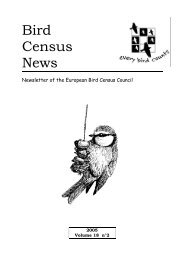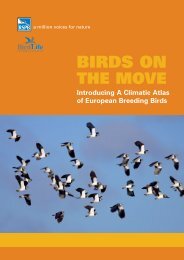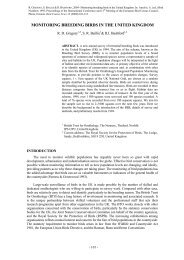Quantifying the impact of land-use change to European farmland ...
Quantifying the impact of land-use change to European farmland ...
Quantifying the impact of land-use change to European farmland ...
Create successful ePaper yourself
Turn your PDF publications into a flip-book with our unique Google optimized e-Paper software.
350 S.J. Butler et al. / Agriculture, Ecosystems and Environment 137 (2010) 348–357<br />
Table 1<br />
Main environmental <strong>impact</strong>s, likely <strong>to</strong> have adverse population scale effects on farm<strong>land</strong> birds, <strong>of</strong> <strong>the</strong> six components <strong>of</strong> agricultural intensification<br />
and two components <strong>of</strong> agricultural abandonment <strong>use</strong>d in <strong>the</strong> risk assessment framework validation process. S, summer; W, winter.<br />
Component <strong>of</strong> agricultural intensification Key <strong>impact</strong>s a<br />
Spring <strong>to</strong> autumn sowing Loss <strong>of</strong> crop foraging habitat (S & W)<br />
Loss <strong>of</strong> crop seeds (W)<br />
Loss <strong>of</strong> crop nest sites<br />
Loss on non-cropped habitat Loss <strong>of</strong> margin foraging habitat (S & W)<br />
Loss <strong>of</strong> hedge foraging habitat (S & W)<br />
Loss <strong>of</strong> margin nest sites<br />
Loss <strong>of</strong> hedge nest sites<br />
Increased agrochemical inputs Loss <strong>of</strong> crop invertebrates (above ground) (S & W)<br />
Loss <strong>of</strong> crop plant material (S & W)<br />
Loss <strong>of</strong> crop seeds (S & W)<br />
Land drainage Loss <strong>of</strong> margin foraging habitat (S & W)<br />
Loss <strong>of</strong> crop invertebrates (soil) (S & W)<br />
Loss <strong>of</strong> crop invertebrates (above ground) (S & W)<br />
Loss <strong>of</strong> margin invertebrates (soil) (S & W)<br />
Loss <strong>of</strong> margin invertebrates (above ground) (S & W)<br />
Loss <strong>of</strong> margin vertebrates (S & W)<br />
Loss <strong>of</strong> hedge invertebrates (soil) (S & W)<br />
Loss <strong>of</strong> margin nest sites<br />
Switch from hay <strong>to</strong> silage and earlier<br />
harvesting<br />
Loss <strong>of</strong> crop foraging habitat (S)<br />
Reduced nesting success (increased mechanical damage)<br />
Intensified grass<strong>land</strong> management Loss <strong>of</strong> crop invertebrates (soil) (S & W)<br />
Loss <strong>of</strong> crop invertebrates (above ground) (S & W)<br />
Loss <strong>of</strong> crop seeds (S & W)<br />
Loss <strong>of</strong> crop vertebrates (S & W)<br />
Loss <strong>of</strong> crop nest sites<br />
Reduced nesting success (increased trampling by s<strong>to</strong>ck)<br />
Loss <strong>of</strong> semi-natural grass<strong>land</strong> Loss <strong>of</strong> crop habitat (S & W)<br />
Loss <strong>of</strong> crop nest sites<br />
Afforestation Loss <strong>of</strong> crop habitat (S & W)<br />
Loss <strong>of</strong> crop nest sites<br />
a ‘Crop’ refers <strong>to</strong> cropped areas <strong>of</strong> <strong>the</strong> <strong>land</strong>scape ra<strong>the</strong>r than <strong>the</strong> actual crop itself, ‘margin’ refers <strong>to</strong> non-cropped open habitats in <strong>the</strong> <strong>land</strong>scape<br />
and ‘hedge’ refers <strong>to</strong> structural vegetation elements in <strong>the</strong> <strong>land</strong>scape such as hedgerows and trees.<br />
2.3. Validation <strong>of</strong> <strong>the</strong> risk assessment framework<br />
2.3.1. Components <strong>of</strong> agricultural intensification and <strong>land</strong><br />
abandonment<br />
To validate <strong>the</strong> framework, we assessed <strong>the</strong> <strong>impact</strong> <strong>of</strong> eight<br />
widespread <strong>land</strong>-<strong>use</strong> and management <strong>change</strong>s, known <strong>to</strong> have significant<br />
detrimental <strong>impact</strong>s on farm<strong>land</strong> birds across Europe over<br />
recent decades (Laiolo et al., 2004; Donald et al., 2006; Wretenberg<br />
et al., 2006; Reif et al., 2008), for <strong>the</strong>ir <strong>impact</strong> on food abundance,<br />
foraging habitat availability, nesting habitat availability and nesting<br />
success (Table 1). Six <strong>of</strong> <strong>the</strong>se <strong>change</strong>s are associated with<br />
agricultural intensification – switch from spring <strong>to</strong> autumn sowing,<br />
increased agrochemical inputs, loss <strong>of</strong> non-cropped habitats,<br />
<strong>land</strong> drainage, <strong>the</strong> switch from hay <strong>to</strong> silage and increased s<strong>to</strong>cking<br />
densities – and two with <strong>land</strong> abandonment – loss <strong>of</strong> semi-natural<br />
grass<strong>land</strong> and active afforestation.<br />
2.3.2. Risk score calculation<br />
To reflect within-species differences in reliance on farm<strong>land</strong><br />
habitat and migration strategy between countries, a pan-<strong>European</strong><br />
risk score for each species was calculated in three stages. Firstly, we<br />
calculated <strong>the</strong> potential summer and winter risk score accrued by<br />
each species in each country if it was present in that season (Stage<br />
1). Individuals from migrant species are not necessarily exposed<br />
<strong>to</strong> <strong>the</strong> winter risk in <strong>the</strong> country in which <strong>the</strong>y breed, ra<strong>the</strong>r <strong>the</strong>y<br />
are exposed <strong>to</strong> <strong>the</strong> winter risk in <strong>the</strong> country or countries in which<br />
<strong>the</strong>y over-winter. We <strong>the</strong>refore calculated <strong>the</strong> <strong>to</strong>tal risk score for<br />
breeding populations <strong>of</strong> each species in a given country by combining<br />
<strong>the</strong>ir potential summer risk score for that country with <strong>the</strong>ir<br />
potential winter risk scores for <strong>the</strong> locations where <strong>the</strong> breeding<br />
birds from that country over-wintered (Stage 2). Finally, we calculated<br />
a pan-<strong>European</strong> risk score as a weighted average based on<br />
relative population size in <strong>the</strong> constituent countries (Stage 3). The<br />
details <strong>of</strong> each stage are outlined below.<br />
2.3.2.1. Stage 1. Using <strong>the</strong> resource requirements matrix, we identified<br />
every species likely <strong>to</strong> have been adversely affected by <strong>the</strong><br />
detrimental <strong>change</strong>s in <strong>the</strong> quantity and quality <strong>of</strong> resources associated<br />
with each agricultural <strong>change</strong> and calculated potential risk<br />
scores for each species in each country. These risk scores reflect<br />
<strong>the</strong> proportion <strong>of</strong> a species’ resource requirements affected by that<br />
<strong>change</strong> and <strong>the</strong>ir reliance on farm<strong>land</strong> <strong>to</strong> provide those resources<br />
(see Butler et al., 2007 and SOM for full details). To accommodate<br />
migration patterns in calculations <strong>of</strong> <strong>to</strong>tal risk (see Stage 2), summer<br />
and winter risks were summed separately across <strong>the</strong> eight<br />
agricultural <strong>change</strong>s at this stage.<br />
2.3.2.2. Stage 2. The potential summer risk score calculated for a<br />
given species in a given country was assigned as <strong>the</strong> summer risk<br />
score accrued by that species in that country if <strong>the</strong> species was<br />
recorded as breeding <strong>the</strong>re. The winter risk score accrued by breeding<br />
populations <strong>of</strong> each species in each country was calculated<br />
based on migration strategy. For resident populations, <strong>the</strong> potential<br />
winter risk score calculated for <strong>the</strong> country in which <strong>the</strong>y breed<br />
was assigned as <strong>the</strong> winter risk <strong>to</strong> which <strong>the</strong>y were exposed. For<br />
partially and fully migrant populations, winter risk scores were calculated<br />
as <strong>the</strong> average <strong>of</strong> winter risk in <strong>the</strong> region(s) where <strong>the</strong>y<br />
over-winter. These regional winter risk scores were calculated as<br />
<strong>the</strong> weighted average <strong>of</strong> <strong>the</strong> potential winter risk scores for each<br />
constituent country in which <strong>the</strong> species is known <strong>to</strong> over-winter.






